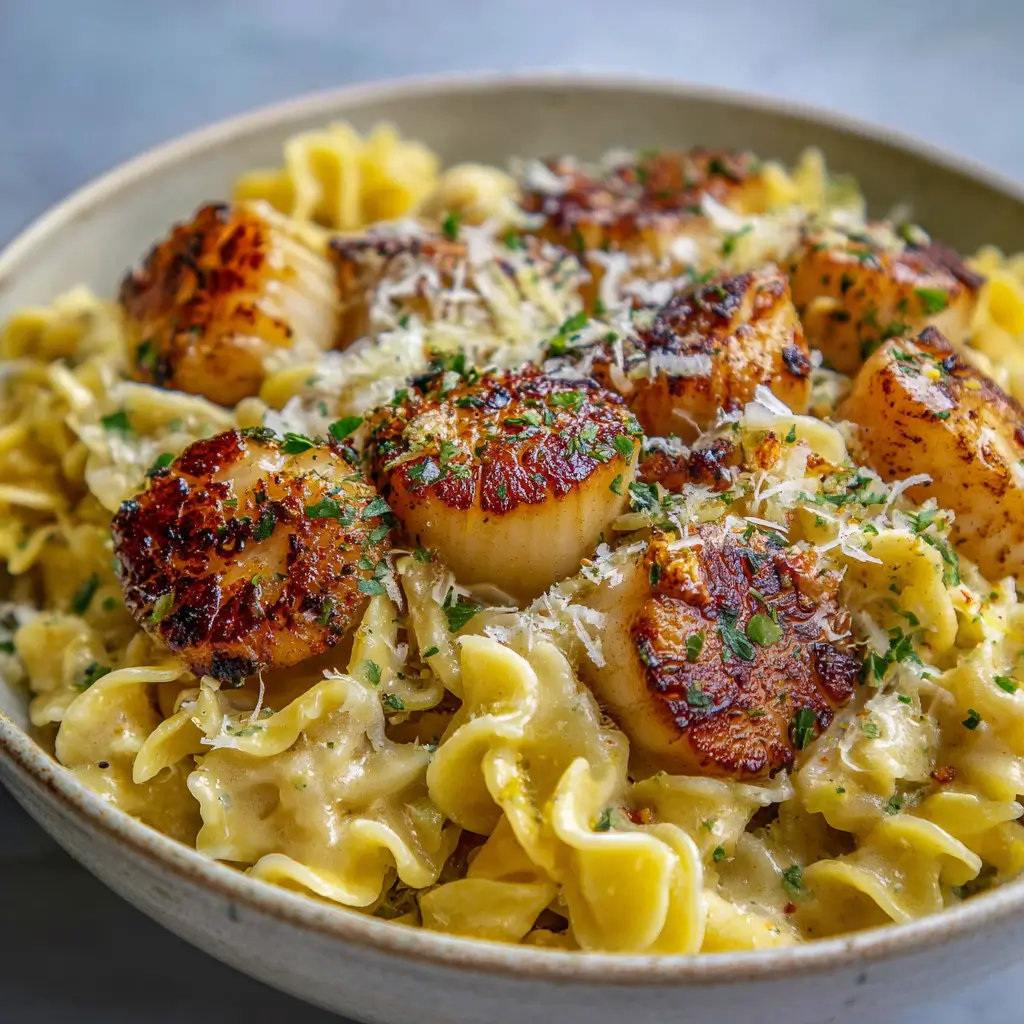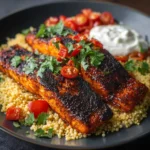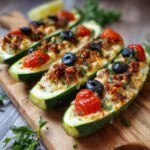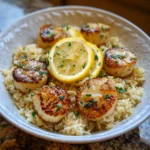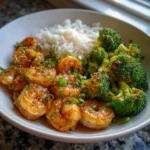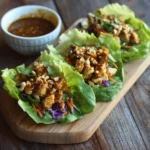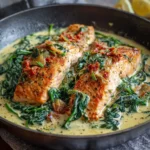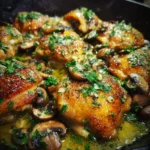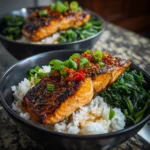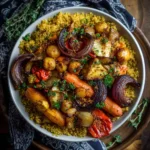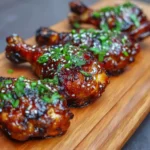Creamy Garlic Butter Scallops with Pasta
Indulge in the luxurious taste of Creamy Garlic Butter Scallops with Pasta—a restaurant-quality dish that’s surprisingly simple to make at home. With tender, seared scallops nestled in a velvety garlic butter sauce and tossed with al dente pasta, this recipe brings together elegance and comfort in every bite. Whether you’re preparing a romantic dinner for two or impressing guests at a dinner party, this dish delivers bold flavors, rich textures, and a touch of culinary sophistication.
The History
The fusion of seafood and pasta has deep roots in Mediterranean cuisine, particularly in coastal regions of Italy where fresh catches are celebrated in daily cooking. While traditional Italian dishes often feature clams, mussels, or shrimp with pasta, scallops have become increasingly popular in modern interpretations due to their sweet, delicate flavor and meaty texture. The use of garlic and butter as a foundational sauce base can be traced back to French and Italian culinary traditions—beurre blanc in France and aglio e olio in Italy both emphasize simplicity and quality ingredients.
Creamy garlic butter sauces gained popularity in American-Italian cuisine during the 20th century, blending European techniques with richer, cream-based elements preferred by many Western palates. Dishes like fettuccine Alfredo paved the way for creamy seafood pastas, and today, recipes such as Creamy Garlic Butter Scallops with Pasta represent a harmonious blend of old-world technique and contemporary flair. This dish embodies the evolution of coastal gastronomy—where freshness meets indulgence.
Ingredients Breakdown
To create the perfect balance of richness, texture, and flavor, each ingredient in this recipe plays a crucial role:
- Sea Scallops: Also known as “diver” or “bay” scallops, these large, moist scallops are ideal for searing. Their natural sweetness pairs beautifully with garlic and butter.
- Fresh Fettuccine or Linguine: These flat noodles hold creamy sauces exceptionally well. Fresh pasta is recommended for its silky texture, but dried works too.
- Unsalted Butter: Provides a rich, smooth base for the sauce. Using unsalted allows better control over seasoning.
- Olive Oil: Used for searing scallops to prevent burning while adding a fruity depth.
- Garlic: The star aromatic. Freshly minced garlic infuses the sauce with pungent, warm notes that mellow when cooked.
- Heavy Cream: Adds luxurious body and silkiness to the sauce, helping it coat every strand of pasta.
- Dry White Wine: Enhances complexity and acidity, balancing the richness. Choose something crisp like Pinot Grigio or Sauvignon Blanc.
- Grated Parmesan Cheese: Salty, nutty, and umami-rich, it thickens the sauce slightly and elevates overall savoriness.
- Fresh Parsley: Brightens the dish with herbal freshness and adds color contrast.
- Lemon Juice: A small splash lifts the entire dish, cutting through the fat and enhancing the scallops’ natural sweetness.
- Salt & Freshly Ground Black Pepper: Essential for seasoning throughout the cooking process.
- Paprika (optional): A pinch adds subtle warmth without heat, enhancing visual appeal with a golden hue.
Step-by-Step Recipe
- Prepare the Scallops: Pat the scallops dry with paper towels—this is critical for achieving a golden sear. Remove the side muscle if still attached. Season lightly with salt and pepper on both sides.
- Cook the Pasta: Bring a large pot of salted water to a boil (use about 1 tablespoon of salt per quart). Add the pasta and cook until just shy of al dente (about 1 minute less than package instructions), as it will finish cooking in the sauce. Reserve 1 cup of pasta water before draining.
- Sear the Scallops: In a large skillet or sauté pan, heat 1 tablespoon olive oil and 1 tablespoon butter over medium-high heat until shimmering. Carefully place scallops in the pan, leaving space between them. Sear undisturbed for 2–3 minutes until deeply golden brown. Flip and cook for another 1–2 minutes until just cooked through. Transfer to a plate and cover loosely with foil.
- Build the Sauce: In the same pan, reduce heat to medium. Add 2 tablespoons butter and let melt. Add minced garlic and sauté for 30–60 seconds until fragrant but not browned. Pour in white wine to deglaze, scraping up any browned bits from the scallops—these add immense flavor. Simmer for 2–3 minutes until reduced by half.
- Add Cream & Cheese: Stir in heavy cream and bring to a gentle simmer. Let cook for 3–4 minutes to thicken slightly. Gradually whisk in grated Parmesan until fully melted and smooth. Season with salt, pepper, and a pinch of paprika if using.
- Combine Pasta & Sauce: Add drained pasta to the sauce and toss to coat. If needed, add reserved pasta water a few tablespoons at a time to loosen the sauce and help it cling to the noodles.
- Finish with Scallops & Herbs: Gently fold in the seared scallops along with lemon juice and chopped parsley. Warm through for 1–2 minutes without boiling, to preserve the scallops’ tenderness.
- Serve Immediately: Divide among warmed bowls. Garnish with extra Parmesan, a drizzle of olive oil, and fresh parsley.
Tips
- Dry Scallops Are Key: Avoid “wet” scallops treated with preservatives—they won’t sear properly. Look for dry-packed, diver-caught scallops when possible.
- Don’t Crowd the Pan: Overcrowding lowers the pan temperature and causes steaming instead of searing. Cook scallops in batches if necessary.
- Use a Cast-Iron or Stainless Steel Skillet: These retain heat better than non-stick pans, promoting an even crust on the scallops.
- Reserve Pasta Water: The starchy liquid helps bind the sauce to the pasta and adjusts consistency without diluting flavor.
- Do Not Overcook Scallops: They should be opaque but still slightly translucent in the center when removed from heat; carryover cooking finishes the process.
- Balancing the Sauce: Taste before serving. If too rich, add more lemon juice. If too sharp, swirl in a bit more butter or cream.
- Prep Ahead: Mise en place is essential—have all ingredients chopped, measured, and ready before starting, as the dish comes together quickly.
Variations and Customizations
This versatile recipe lends itself to numerous creative adaptations:
- Gluten-Free Option: Use gluten-free pasta made from rice, corn, or chickpeas. Ensure all other ingredients are certified GF.
- Dairy-Free Version: Substitute butter with vegan butter or olive oil, and use coconut cream or cashew cream instead of heavy cream. Skip Parmesan or use nutritional yeast for a cheesy note.
- Add Vegetables: Spinach, sun-dried tomatoes, artichoke hearts, or roasted cherry tomatoes add color, nutrition, and tang.
- Protein Swaps: Replace scallops with shrimp, lobster, or even grilled chicken for a different twist.
- Herb Variations: Try basil, chives, or tarragon instead of parsley for unique aromatic profiles.
- Spicy Kick: Add red pepper flakes when sautéing garlic for a hint of heat.
- Wine-Free Version: Omit wine and use extra pasta water with a splash of apple cider vinegar or lemon juice for acidity.
- Truffle Elegance: Drizzle truffle oil at the end or shave fresh black truffle for a gourmet upgrade.
Health Considerations and Nutritional Value
While undeniably decadent, this dish can be adapted for various dietary needs and enjoyed in moderation as part of a balanced diet.
Nutritional Highlights (per serving, approx. 1/4 of recipe):
- Calories: ~550–650 kcal
- Protein: ~28g – High-quality protein from scallops supports muscle repair and satiety.
- Fat: ~30g – Primarily from healthy fats in butter, olive oil, and cream. Contains saturated fat, so best consumed occasionally.
- Carbohydrates: ~45g – Mainly from pasta; choose whole grain or legume-based pasta to increase fiber and nutrients.
- Omega-3 Fatty Acids: Scallops provide a modest amount of heart-healthy omega-3s.
- Vitamins & Minerals: Rich in selenium, vitamin B12, phosphorus, and iodine from scallops. Garlic supports immune function, while parsley offers vitamin K and antioxidants.
For Heart Health: Reduce butter and cream quantities, or use half-and-half. Opt for olive oil as the primary fat.
Low-Sodium Option: Use low-sodium butter, skip added salt, and rely on herbs, lemon, and garlic for flavor.
Portion Control: Serve with a large side salad or steamed vegetables to balance the meal and reduce overall calorie density.
Ingredients
- 1 lb (450g) dry sea scallops, patted dry
- 12 oz (340g) fresh fettuccine or linguine (or dried)
- 3 tbsp unsalted butter, divided
- 2 tbsp olive oil, divided
- 4 cloves garlic, finely minced
- 1/2 cup dry white wine (e.g., Pinot Grigio)
- 1 cup heavy cream
- 1/2 cup freshly grated Parmesan cheese, plus more for serving
- 1/4 cup fresh parsley, chopped
- 1 tbsp fresh lemon juice (about 1/2 lemon)
- Salt and freshly ground black pepper, to taste
- Pinch of paprika (optional)
Directions
- Season scallops with salt and pepper. Heat 1 tbsp olive oil and 1 tbsp butter in a large skillet over medium-high heat. Sear scallops 2–3 minutes per side until golden and just cooked through. Transfer to a plate and cover.
- Bring a large pot of salted water to a boil. Cook pasta until just under al dente. Reserve 1 cup pasta water, then drain.
- In the same skillet, reduce heat to medium. Melt 2 tbsp butter, add garlic, and sauté 30 seconds until fragrant.
- Pour in white wine, scrape the bottom of the pan, and simmer 2–3 minutes until reduced by half.
- Stir in heavy cream and bring to a gentle simmer. Cook 3–4 minutes to thicken slightly.
- Whisk in Parmesan until smooth. Season with salt, pepper, and paprika if using.
- Add cooked pasta to the sauce. Toss well, adding reserved pasta water as needed to reach desired consistency.
- Gently fold in scallops, lemon juice, and parsley. Warm for 1–2 minutes without boiling.
- Serve immediately in warm bowls, garnished with extra Parmesan and parsley.
FAQ
Q: Can I use frozen scallops?
A: Yes, but ensure they are thawed completely in the refrigerator overnight and patted very dry before searing. Frozen scallops may release more moisture, affecting the sear.
Q: What kind of pasta works best?
A: Long, flat pastas like fettuccine, linguine, or tagliatelle hold the creamy sauce best. However, campanelle or casarecce also work well due to their textured surfaces.
Q: My sauce is too thin—how can I thicken it?
A: Simmer longer to reduce, or add a bit more Parmesan. Alternatively, mix 1 tsp cornstarch with 1 tbsp cold cream and stir in, then simmer briefly.
Q: Can I make this ahead of time?
A: Best served fresh. However, you can prep components separately: cook pasta (rinse in cold water and toss with oil), make sauce, and sear scallops. Reheat gently and combine just before serving.
Q: Are there sustainable scallop options?
A: Yes. Look for U.S.-farmed or diver-caught scallops, which are typically more sustainable than mechanically harvested ones. Check resources like Seafood Watch for current recommendations.
Q: Can I freeze leftovers?
A: Not recommended. Cream-based sauces may separate when frozen and reheated, and scallops become rubbery. Store in the fridge for up to 2 days and reheat gently on the stove with a splash of cream or water.
Summary
Creamy Garlic Butter Scallops with Pasta is an elegant, flavorful dish that combines perfectly seared scallops with a luscious garlic Parmesan cream sauce and tender pasta. Quick to prepare yet impressive enough for special occasions, it’s a masterpiece of comfort and refinement on a plate.
